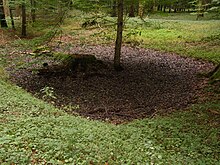Swale (landform)

A swale is a shady spot, or a sunken or marshy place.
On land
The use of swales has been popularized as a rainwater-harvesting and soil-conservation strategy by Bill Mollison, David Holmgren, and other advocates of permaculture. In this context a swale is usually a water-harvesting ditch on contour, also called a contour bund.[4][5]

Swales as used in permaculture are designed by permaculturalists to slow and capture runoff by spreading it horizontally across the landscape (along an
In arid and seasonally dry places, vegetation (existing or planted) in the swale benefits heavily from the concentration of runoff. Trees and shrubs along the swale can provide shade and mulch which decrease evaporation.
On beaches
The term "swale" or "beach swale" is also used to describe long, narrow, usually shallow troughs between ridges or
See also
References
- ^ Chambers Dictionary, Edinburgh, 1998, p. 1668.
- ^ "Storm Water Technology Fact Sheet: Vegetated Swales". Washington, D.C.: U.S. Environmental Protection Agency (EPA). September 1999. EPA 832-F-99-006.
- ^ "Stormwater Best Management Practice: Grassed Swales" (PDF). EPA. December 2021. p. 3. EPA 832-F-21-031P.
- ^ "Water Harvesting: Microcatchment Contour Bunds". Food and Agriculture Organization. Retrieved 2009-11-26.
- ^ "Soil contour bunds" (PDF). mamud.com. United Nations Office for Project Services. 1998. Archived from the original (PDF) on 2017-05-17. Retrieved 2009-11-26.
- ^ "Wetlands of the Great Lakes Open Shoreline and Embayed Wetlands". Michigan State University Extension. July 31, 2010. Archived from the original on July 31, 2010. Retrieved September 21, 2009.
